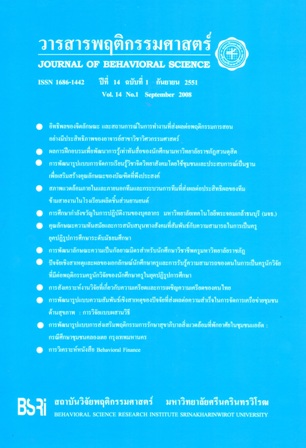การพัฒนารูปแบบการส่งเสริมพฤติกรรมการรักษาสุขาภิบาลสิ่งแวดล้อมที่พักอาศัยในชุมชนแออัด : กรณีศึกษาชุมชนคลองเตย กรุงเทพมหานคร (Model Development for Promoting Household Environment and Sanitation Behaviors in the Slum Area : a Case Study of Khlong Toei Community, Bangkok)
Abstract
The objectives of this research were as follows : 1) to study the result of the model for promoting household environment and sanitation behaviors within the slum areas. These were factors including the operating for project activities in the aforementioned community, and 2) to study the effects on people’s satisfaction and the quality of household environment and sanitation after the monitor model. The samples of this study comprised 25 participants who were the parents at Duang Prateep Kindergarten represented from 4 communities in Khlong Toei Sub-district, Khlong Toei District, Bangkok Metropolitan. These participants were selected by purposive sampling.
The procedure were organizing the work shop using Appreciation Influence and Control (AIC) Process. They were divided into 5 stages : 1) Condition Analysis and Future Provision 2) Development Initiation 3) Procedure Creation 4) Plan Action and 5) Evaluation and Improvement. The data were collected by quantitative and qualitative methods. The quantitative data were obtained before and after the model activities using questionnaires. The statistical analysis were : percentage, mean and standard deviation, and inferential statistics (t-test) to compare mean scores before and after the model activities. The qualitative data from group discussion and observation were analyzed using content analysis.
The results of this study were concluded as follows :
1) After the model activities, mean scores of all selected factors associated with household environment and sanitation behaviors : perception, self-esteem, self-efficacy expectation, intension to practice and to practice behaviors were significantly higher than those before the model activities (p<.001).
2) At the action stage, sixteen projects activities were developed and could resolve household environment and sanitation problems in the action area, although the other people provided less cooperation in these activities. However it appealed to these people be awakened to this problems after the activities and there were 8 projects continuous operation in the communities.
3) During the focus group discussion proceeded, it was found that almost of the participants in this study participated and very satisfied with the model activities.
4) Before the model activities, the household environment and sanitation quality in 4 communites was not well enough, but after that it was better only at the limit of action areas.
Keywords : model development, household environment and sanitation behaviors, slum area, Khlong Toei community
บทคัดย่อ
การวิจัยครั้งนี้ มีวัตถุประสงค์เพื่อ 1) ศึกษาผลของการพัฒนารูปแบบการส่งเสริมพฤติกรรมการรักษาสุขาภิบาลสิ่งแวดล้อมที่พักอาศัยในชุมชนแออัด ได้แก่ การเปลี่ยนแปลงของปัจจัยที่ศึกษาและผลการดำเนินโครงการที่เกิดขึ้นในชุมชน และ 2) ศึกษาผลกระทบที่เกิดขึ้นภายหลังดำเนินการในการพัฒนารูปแบบในด้านความพึงพอใจของกลุ่มตัวอย่างที่ได้เข้าร่วมกิจกรรม รวมทั้งการเปลี่ยนแปลงคุณภาพการสุขาภิบาลสิ่งแวดล้อมที่พักอาศัยในชุมชน กลุ่มตัวอย่างในการศึกษาครั้งนี้คือ ผู้ปกครองนักเรียนของโรงเรียนอนุบาลดวงประทีป จำนวน 25 คน พักอาศัยในชุมชน 4 แห่ง ในแขวงคลองเตย เขตคลองเตย กรุงเทพมหานคร การคัดเลือกกลุ่มตัวอย่างเป็นแบบเฉพาะเจาะจง
กระบวนการดำเนินการวิจัย โดยการจัดประชุมเชิงปฏิบัติการตามแนวทางของเทคนิคเอไอซี แบ่งออกเป็น 5 ขั้นตอน ได้แก่ 1) ขั้นตอนวิเคราะห์สภาพการณ์และกำหนดอนาคต 2) ขั้นตอนการสร้างแนวทางพัฒนา 3) ขั้นตอนการสร้างแนวทางปฏิบัติ 4) การปฏิบัติตามแผน และ 5) ขั้นตอนการประเมินผลและปรับปรุงแผน การเก็บรวบรวมข้อมูลด้วยวิธีเชิงปริมาณ และเชิงคุณภาพ การเก็บข้อมูลเชิงปริมาณจากแบบสอบถามทั้งก่อนและหลังการดำเนินกิจกรรม วิเคราะห์ด้วยสถิติเชิงพรรณนา ได้แก่ ร้อยละ ค่าเฉลี่ย ส่วนเบี่ยงเบนมาตรฐาน และสถิติ t-test เพื่อเปรียบเทียบค่าเฉลี่ยของปัจจัยที่ศึกษาระหว่างก่อนและหลังการดำเนินกิจกรรม และมีการเก็บข้อมูลเชิงคุณภาพจากการสนทนากลุ่มและการสังเกต วิเคราะห์โดยการวิเคราะห์เนื้อหา
ผลการวิจัยมีดังนี้
1) จากการวิเคราะห์ผลการเปลี่ยนแปลงพฤติกรรมการรักษาสุขาภิบาลสิ่งแวดล้อมที่พักอาศัยและปัจจัยที่เกี่ยวข้องของกลุ่มตัวอย่าง ได้แก่ การรับรู้ การเห็นคุณค่าในตนเอง ความคาดหวังในความสามารถตนเอง และความตั้งใจในการปฏิบัติ พบว่า ภายหลังดำเนินการในการพัฒนารูปแบบ ค่าเฉลี่ยของปัจจัยที่ศึกษาสูงขึ้นกว่าก่อนดำเนินการอย่างมีนัยสำคัญทางสถิติ (p<.001)
2) ในการดำเนินการ มีโครงการเกิดขึ้นจำนวน 16 โครงการ โครงการส่วนใหญ่สามารถแก้ปัญหาการสุขาภิบาลสิ่งแวดล้อมที่พักอาศัยเฉพาะบริเวณที่มีการดำเนินกิจกรรม การดำเนินกิจกรรมในชุมชนได้รับความร่วมมือจากประชาชนไม่มากนัก แต่ก็ทำให้ประชาชนมีการตื่นตัวเกี่ยวกับการรักษาสุขาภิบาลสิ่งแวดล้อมที่พักอาศัยเพิ่มขึ้น และมีจำนวน 8 โครงการ ที่ยังคงดำเนินในชุมชนต่อไป
3) จากการสนทนากลุ่มกับกลุ่มตัวอย่างที่เข้าร่วมกิจกรรม พบว่ากลุ่มตัวอย่างเกือบทั้งหมดเข้าร่วมกิจกรรมและมีความพึงพอใจในรูปแบบในระดับมาก
4) การสุขาภิบาลสิ่งแวดล้อมที่พักอาศัยในชุมชนที่ทำการศึกษาทั้ง 4 แห่ง ก่อนระยะดำเนินการมีคุณภาพไม่ดี แต่เมื่อสิ้นสุดระยะดำเนินการพบว่าบริเวณที่มีการดำเนินกิจกรรมมีคุณภาพดีขึ้นในขอบเขตบริเวณที่มีการดำเนินกิจกรรม
คำสำคัญ : การพัฒนารูปแบบ พฤติกรรมการสุขาภิบาลสิ่งแวดล้อมที่พักอาศัย ชุมชนแออัด ชุมชนคลองเตยDownloads
Downloads
How to Cite
Issue
Section
License
Behavioral Science Research Institute, SWU
114 Sukhumvit 23, Bangkok 10110, Thailand.
Tel.02-649-5000 # 17600



